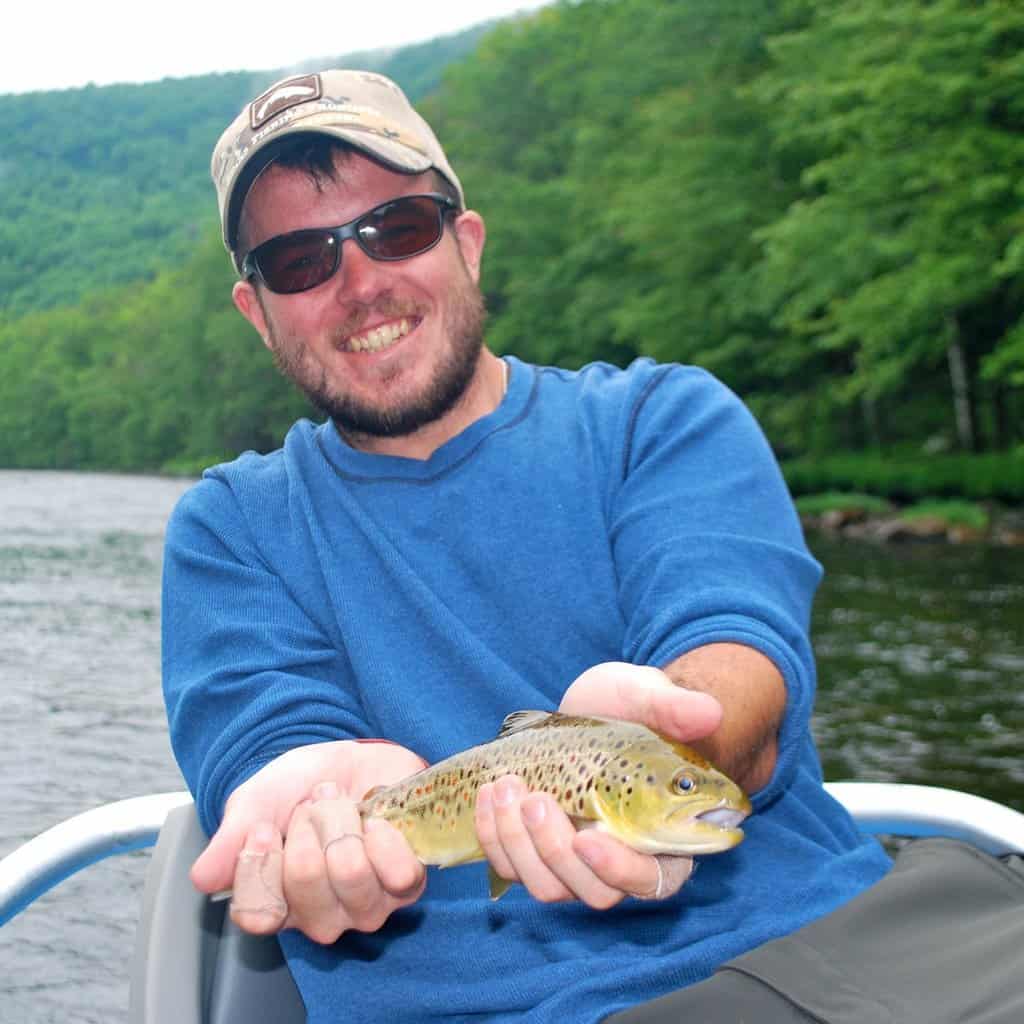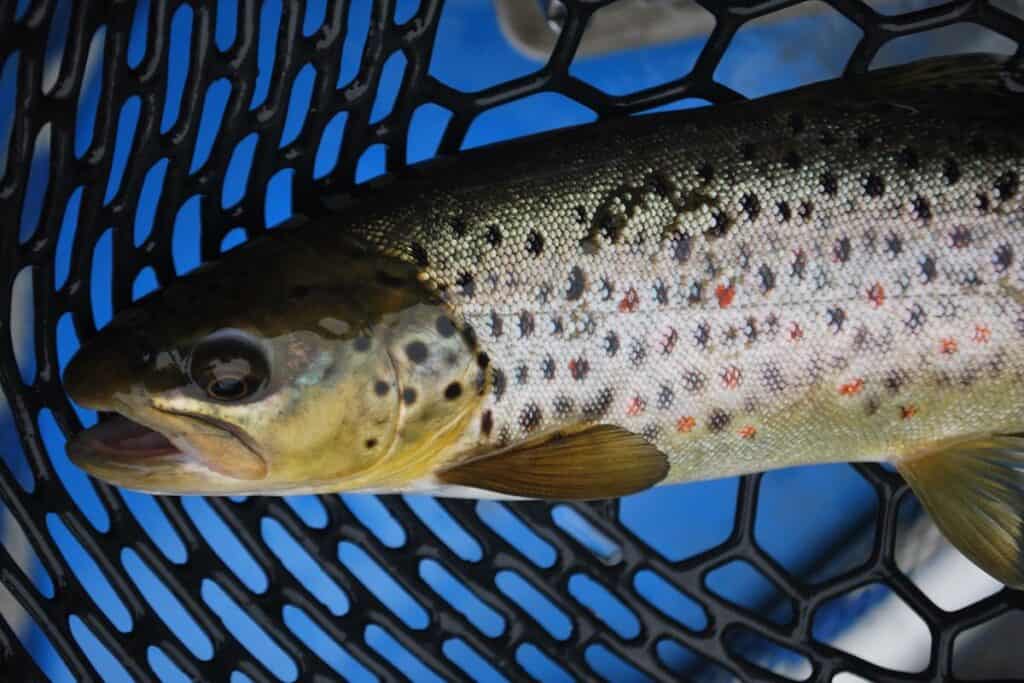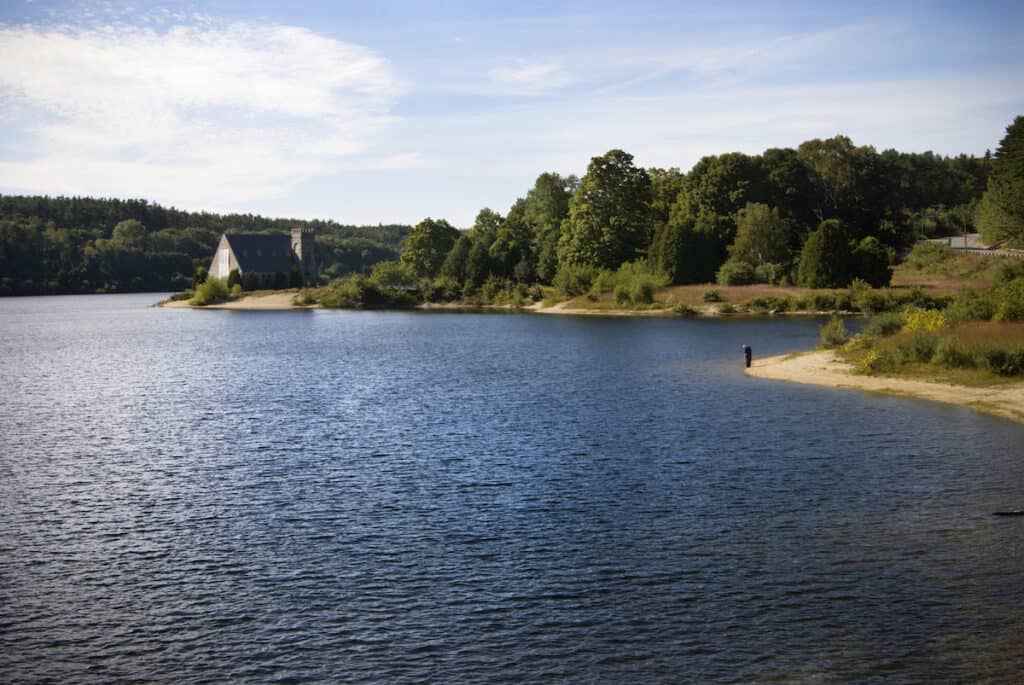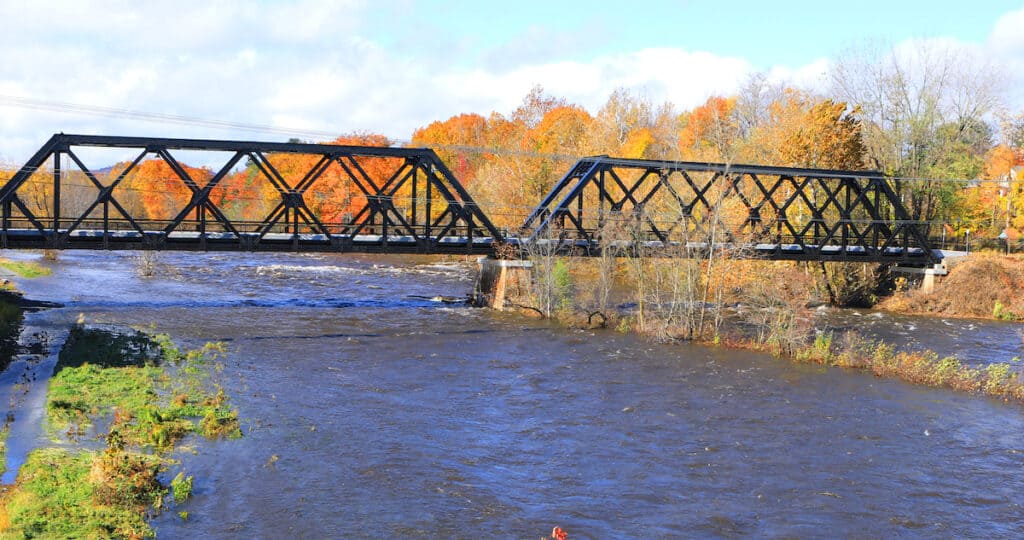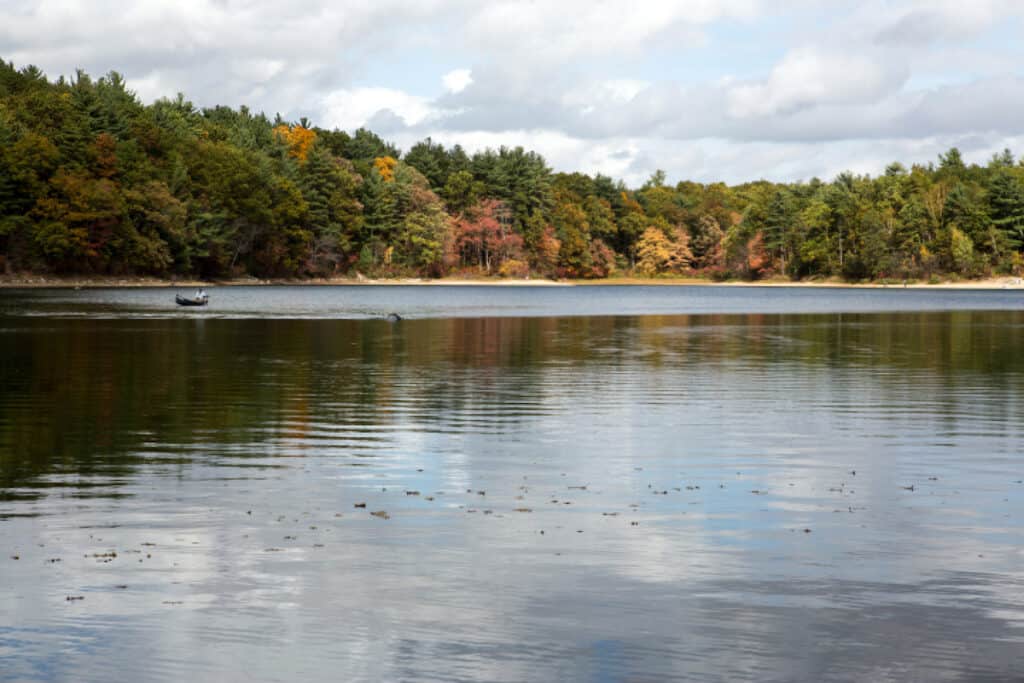Saltwater fishing sometimes gets all the glory in Massachusetts, while the state’s trout streams and lakes can be overlooked and underfished.
But that would be a mistake. From the remote woods of Western Massachusetts to the salty air of Cape Cod, you can catch brown, brook, rainbow, lake, and even a few tiger trout across the Bay State.
This article will show you the best trout fishing rivers, lakes, reservoirs and ponds across Massachusetts.
We also reveal many of the tips that will improve your odds of catching trout in each water, as well as the best spots to access each location to catch more fish.
Deerfield River
If you don’t already know why the Deerfield landed at the top of our list, consider this: A few years back, Fly Fisherman Magazine reported that guide Chris Jackson caught a 34-inch, 16-pound brown trout in the river.
To our knowledge, anglers have caught and released that fish twice more since then, and it may still be swimming in the Deerfield today.
The Massachusetts Department of Fish and Game stocks brown and rainbow trout in the Deerfield in the spring, but a dozen sites along the river are typically stocked again in October.
The areas stocked with thousands of trout each year stretch between Sherman Reservoir in Western Massachusetts and the Connecticut River.
The river flows through the 6,000-acre Mohawk Trail State Forest, one of the state’s most scenic areas. So you’re guaranteed good access as well.
Access: To the east of the Monroe State Forest, the Dunbar Brook Picnic Area sits right along the river’s bank and offers parking and stream access. Farther south, near Rowe, the Zoar Picnic area provides public access. Finally, the East Charlemont Boat Launch, just south of the Catamount State Forest, offers additional access.
Farther upriver, the Deerfield also makes a splash among the best trout fishing rivers and lakes in Vermont.
Wachusett Reservoir
The ‘Chu covers 108 square miles and holds 65 billion gallons of water, making it, along with Quabbin Reservoir, one of the most popular freshwater fishing destinations in Massachusetts.
Because Wachusett Reservoir stores public drinking water, special regulations do apply. For example, only shore fishing is allowed, and the season runs from the first Saturday in April and ends on December 1.
Lake trout are the big draw in Wachusett, and for a good reason. A 2017 creel survey showed good numbers of fish from the 18- to 24-inch range.
Wachusett Reservoir has given up a previous state-record lake trout as well.
But there are more than just big lakers in Wachusett. The reservoir also produced the current state records for both brown and rainbow trout.
Brown trout are the most popularly caught fish these days, and casting spoons in the ½- to ¾-ounce range will enable you to cast a distance from shore and reach brown and lake trout.
Wachusett offers 37 miles of shoreline, and more than 80 percent of it is accessible to the public for bank fishing.
Access: There is parking near the dam in the Clinton area along Boylston Street at River Avenue. Additional parking is available in the West Boylston area.
Quabbin Reservoir
One of the great elements about fishing massive Quabbin Reservoir is that you can show up with your rod, reel and tackle, and the rest will be waiting for you as you fish for lake, brown and rainbow trout.
The lake has produced record-sized fish, including a 25-pound-plus lake trout.
You can rent a fishing boat on-site for a reasonable fee. You can rent canoes and kayaks, too. Read the link and note the life jacket requirement.
Some of the reservoir’s best trout water is on Quabbin’s western arm, which has deeper water.
When casting from shore, spoons like Kastmasters and Little Cleos on light gear can reach past near-shore drop-offs where fish will be holding.
Boaters can do well by trolling, and trolling fresh shiners is a favorite tactic for catching big lake trout.
However, Bill Roy caught that record-sized laker we mentioned earlier while trolling a gold Mooselook Wobbler at 2.5 miles per hour at the beginning of June. So keep that in mind if you head to Quabbin.
Quabbin Reservoir also is among our picks for top bass fishing lakes in Massachusetts.
Access: Gate 8, also delineated as boat launching area number 1, is 4.5 miles north of the intersection of routes 9 and 202 in Pelham and is close to deeper water that at times will be best for trout.
More: Complete Guide to Quabbin Reservoir Fishing
Westfield River
The Westfield River, in the area of – you guessed it – Westfield, is one of Western Massachusetts’ gems.
More than 78 miles of the river are designated as “wild and scenic” because it flows through one of the largest roadless areas in Massachusetts. The area provides crucial habitat for bears, waterfowl and, of course, trout.
There are bridges along the Westfield that date back as far as 1840. Sections are popular for whitewater rafters as well as canoeing and kayaking anglers.
N. West Street runs through Robinson State Park, offering anglers access to a good section of the Westfield River.
There are populations of wild brown and brook trout in the river, and it also is stocked with a healthy number of browns every year.
Below the Knightville Dam north of Huntington, you’ve got good chances at large, holdover rainbow trout as well.
You’re more apt to find brook trout in the headwaters around the Upper Westfield River Wildlife Management Area near Windsor.
Access: River Road flows through the Wildlife Management Area north of the Berkshire Trail (Route 9).
Swift River
The Swift River might not get the hype and publicity that the Deerfield does, but it has healthy populations of brown trout, rainbow trout and wild brook trout.
It’s definitely worth getting to know for any Northeast trout angler.
Fly anglers, especially, should take note of the reach from the Windsor Dam down to where Route 9 crosses the stream, which is open to fly fishing only.
This section, directly below Quabbin Reservoir, benefits from cold-water releases, making it an ideal stretch to target in warmer months like June and July. It’s a great spot to keep in mind when nearby rivers get warm and challenging.
The river typically receives additional stockings of rainbow trout mid-summer, according to Massachusetts DFW.
There are healthy hatches of bluewing olives that are a popular choice for fly anglers looking to match the hatch. Mepps, Phoebes and Rooster Tails are all strong lure selections for the spinning set.
Access: The Swift River Wildlife Management Area, off Route 9 near the intersection of Enoch Sanford Road and East Street, offers river access for shore anglers. Also, there is a boat launch downstream near the Cold Spring Road river crossing.
Hoosic River
The Hoosic flows all the way from the Cheshire Reservoir in Massachusetts to the Hudson River in Stillwater, New York, and it offers some fantastic trout fishing along the way.
Popular tributaries include the Little Hoosic, Hoosic North Branch, Green River, the Owl Kill, the Tomhannock and the Walloomsac.
The river and its tributaries sport healthy populations of wild rainbow and brown trout, and collectively these streams don’t receive as much pressure as more famous rivers. Nevertheless, rainbows pushing 20 inches and brown trout of 24 inches or more aren’t unheard of on stretches of the Hoosic.
Access: Lower Linear Park borders the banks of the Hoosic, where the Green River and Phoebe’s Brook flow into the mainstem. You’ll find this public land and access off Elm Street in Williamstown.
Green River
This Green River flows from Marlboro, Vermont, winds through Northern Massachusetts, and eventually dumps into the Deerfield River near Greenfield (and not far above the Deerfield’s merging with the Connecticut River).
The Green River is a wise choice if you’re looking for a western Massachusetts river with good catch rates because it is stocked both in the spring and the fall with brown trout. Leyden Road, near Murphy Park, will lead you to the Green River Conservation Land where anglers have public access.
The state has also stocked rainbow trout in the river some seasons, perhaps giving anglers a shot at both species.
Access: Head to Murphy Park in Greenfield.
Squannacook River
Starting in the Squannacook River State Wildlife Management Area, the Squannacook flows from northern Massachusetts, right near the state border with New Hampshire, into the Squanacock Reservoir in West Groton.
Want to try to manage a mouthful? Tell people you’re going to the Squannacook Conservation area off Squannacook Road to fish the Squannacook River. As it so happens, that’s a prime point of access.
There’s a canoe-launch site just south of the intersection of West Main Street and Townsend Road in Groton.
The Wildlife Management Area reportedly also is a favorite among birdwatchers, meaning you’ll have some great company on the water. There have even been moose sightings reported.
The river’s main stem is stocked with browns in the spring and fall, and brookies live in the tributaries.
Access: The P. Bertozzi Wildlife Management Area is ideal for anglers. It’s at the end of Squannacook Drive in West Groton.
Millers River
Starting at the confluence of Bear Meadow Brook and Bluefield Brook in Ashburnham, Millers River flows through Sunset Lake and eventually empties into the Connecticut River near Millers Falls.
The upper section of the river features faster, colder water, whereas the river slows down as it flows west. It can support brown, brook and rainbow trout in its upper stretches, which the state stocks in the spring. Rainbows are often stocked again in the fall.
The upper river between routes 68 and 2A in Athol is a catch-and-release-only section that must be fished with artificial lures. Small spoons and spinners like Little Cleos or Kastmasters will work well in this shallow stream.
For fly anglers, Hendrickson and Caddis hatches are popular in the early spring, and streamers like woolly buggers will work best in the fall.
In the warmer downstream sections, you’re more apt to hook up with a smallmouth bass, rock bass or fallfish.
Access: Bearsden Road runs through Bearsden Forest Conservation Area, with angler parking right where that road enters the southwest corner of the park. Larger rocks and slippery sections can make for difficult wading, so take care.
Long Pond
There are two Long Ponds in Massachusetts, one on Cape Cod, and one near Plymouth, and both offer good fishing.
Here we’re talking about the Long Pond in Plymouth, stocked annually with rainbow trout, brown trout, brook trout – and when the state has them available – tiger trout.
The 227-acre pond has two holes that reach deeper than 90 feet, which you can pinpoint on this state DFW map.
Plymouth’s Long Pond has a reputation for producing big brown trout to 14 pounds, and anglers trolling spoons generally have the best luck.
There’s plenty of shoreline access, and anglers have caught rainbows, browns, brook and tiger trout that meet the minimum size requirements for the freshwater fishing rewards program.
By the way, tiger trout are a cross between a brook and a brown trout usually produced in a hatchery. If you’ve never seen one, Google them: They are a visually enticing fish to target.
Access: There’s lots of bank fishing access, plus a boat ramp off Clark Road on the northwest corner.
Ashfield Lake
Ashfield Lake on the South River, a tributary of the Deerfield, holds the Massachusetts state record brook trout.
On April 19 of 2008, Peter Harand caught a brookie the size of which most of us don’t even dream about: He landed a 10-pound broke trout from Ashfield. Keep in mind average Massachusetts brook trout are typically between 10 and 12 inches, and the previous record was a 6-pound, 4-ounce fish caught in 1968.
Basically, if you’ve got a body of water that can produce a brook trout that nearly doubles a state record that had stood for almost exactly 40 years. … Yeah, that’s going to make our best-trout-waters list. That fish was only 4 pounds shy of the world record caught in Ontario.
If there was one brook trout that size, it stands to reason the lake could grow some more very respectable ones.
Ashfield Lake reaches depths of only about 15 or 20 feet at its center and covers 37 acres, making it a relatively small body of water to cover.
Access: You’ll find pond access off Rte.116 in the southwest corner of the pond.
Lake Onota
This is another lake that gives you a decent shot at brown trout, rainbow trout, brook trout and tiger trout, and that variety helped it earn a spot on our Massachusetts trout list.
This Pittsfield-area lake was at one time designated as a special brown trout fishery, and for a period, the state limited anglers to keeping one fish that exceeded 15 inches in length. That designation is no longer in place, but it speaks to the trophy fishery that exists at Onota Lake.
The southeast corner of the lake gets the deepest at 60-plus feet, and will hold fish in the warmest summer months.
Lake Onota also made our list of the best ice-fishing lakes in Massachusetts.
Access: There is a fishing pier and a boat launch right off Lakeway Drive on the lake’s east side.
Cliff Pond
If you were only going to target trout on one Cape Cod pond, it’d have to be Cliff Pond, which gets the most generous stocking from the state.
The 206-acre pond is in Nickerson State Park, which I’d highly recommend you visit if you’re on the Lower Cape.
Nickerson is a great stop because it has a variety of ponds of all sizes with largemouth, smallmouth and of course brown, brook and rainbow trout. The bike trails throughout the park are well-maintained, and the wildlife is incredible.
And if you’re not having luck on Cliff, you can hop out and fish Little Cliff, Higgins Pond or Flax Pond within walking distance in the park.
Nickerson is truly worth at least one afternoon if you’re going to be near Brewster on the Lower Cape.
Access: Cliff Pond Beach off of Flax Pond Road will give you your easiest spot to launch a canoe or kayak.
More: Find all sorts of freshwater and saltwater angling opportunities in our Complete Guide to Fishing Cape Cod.
Walden Pond
In Walden Pond you’ve got a very clear, deep pond without much vegetation, making it an ideal habitat for trout.
The pond near Concord has populations of largemouth and smallmouth bass, but it is considered a trophy trout pond. Brook, brown and rainbow trout that meet the minimum requirements to be considered a “trophy” catch in Massachusetts have all come out of Walden.
Walden is only a 62-acre pond, but it does reach depths of more than 100 feet, at a hole west of its centermost point. Its southwestern shore features the steepest drops.
Salmon eggs, spoons, spinners and streamers are all popular offerings fished here by conventional and fly anglers.
Working those steep shelves on the southern shore at first and last light in the spring and fall will be your best bet from shore.
And, yes, lit majors and Henry David Thoreau Fan Club members, this is that Walden Pond.
Access: The boat ramp is off Route 126 in the southeast corner of the pond.
White Pond
If you’re looking for a shot at the visually stunning tiger trout, but don’t want to hunt through as much water as you might on Walden Pond, try the smaller White Pond, also in Concord.
There are a couple of reasons that the 40-acre White Pond makes our list, and one is that it gives you shots at brown, rainbow and tiger trout.
Another reason White made our list is that it is among the Massachusetts ponds stocked both in the spring and the fall, so you’ve got great shots at trophy-sized trout year-round.
White Pond has mostly a sand bottom without much vegetation, so you shouldn’t have to clean your lure of weeds every other cast.
It’s important to note that this pond is designated for cartop boat, canoe or kayak use only, and outboard motors are prohibited. This restriction limits pressure, pollution and crowding.
Looking for a loophole? You can use an electric motor, so a relatively inexpensive trolling motor to put on a canoe or kayak can save you if your arms are getting tired and provide a stealthy way to approach promising points.
Access: There is a canoe launch off Plainfield Road.
Quacumquasit (South) Pond
Quacumquasit and Quaboag ponds are right next to one another in Brookfield, and both offer good fishing.
Whereas Quaboag is a shallower pond with depths rarely exceeding 10 feet, South Pond reaches depths of more than 70 feet at its center, increasing its ability to offer productive fishing for a longer season.
The Massachusetts Department of Game and Fish at one point designated South Pond as a “special trout water,” where only one brown trout of larger than 15 inches could legally be kept.
The state designates waters to protect and enhance its best fisheries for each given species and ensure that the biggest trout, in essence, have the best shot to continue to get bigger.
Big browns are the main target here, and spoons like a Kastmaster can be productive.
And if you’re not having much luck at Quacumquasit Pond, hey, you’re a hop, skip and a jump from Quaboag Pond just to the north.
Access: A lot and launch off Lake Road in Brookfield can accommodate 15 cars and offers a paved launch.
Housatonic River
In the Housatonic, you’ve got an enormous river that can give you shots at brown trout, rainbow trout, smallmouth bass, largemouth bass, northern pike and more, depending on where you fish.
There are varying regulations throughout. For example, a catch-and-release only area exists from the Glendale Dam down to the Boston and Maine Railroad bridge in Stockbridge.
The summer months of July and August tend to lift water temperatures too high for active trout populations.
The state is doing its best to protect a unique and beautiful habitat, too. The upper section will be the best bet for trout fishing.
The Upper Housatonic River Area of Critical Concern is a 13-mile corridor that stretches from Pittsfield to Lee. It features wild, native brook trout populations in the river and bear and moose roaming the banks. This is the prime area for trout fishermen to roam as well.
Streams in this section flowing into the Housatonic, including Mill Brook, Ashley Brook, Sackett Brook, Washington Mountain Brook, Yukon Brook, Roaring Brook and the outflow of Felton Pond all support reproducing populations of brown and/or brook trout.
Access: Parking and access to the catch-and-release section of the Housatonic is at the intersection of Route 183 and Dugway Road.
Downstream, the Housatonic River also made it into our rundown of the best trout fishing rivers and lakes in Connecticut.
Summary
No matter what time of year you’re fishing, Massachusetts offers opportunities to target some beautiful brown, brook, rainbow, tiger and lake trout in various settings.
Often the biggest challenge we anglers can overcome is taking a risk, trying new water, and making those first casts into rivers, lakes and ponds we’ve never fished. We hope this guide helps you make more of those casts.
Catch More Trout
Still getting up to speed on this type of fishing? We have a simple guide to trout fishing techniques and tips just for you.

